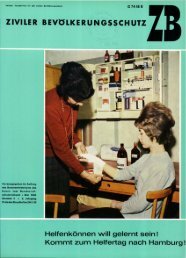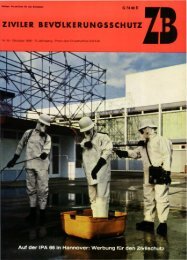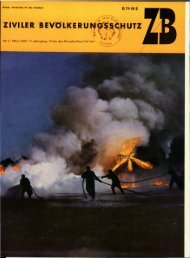Zivilschutz- Forschung - Bundesverwaltungsamt
Zivilschutz- Forschung - Bundesverwaltungsamt
Zivilschutz- Forschung - Bundesverwaltungsamt
Erfolgreiche ePaper selbst erstellen
Machen Sie aus Ihren PDF Publikationen ein blätterbares Flipbook mit unserer einzigartigen Google optimierten e-Paper Software.
166. Sharp, T. W., R. J. Brennan, et al. (1998). „Medical preparedness for a terrorist<br />
incident involving chemical or biological agents during the 1996<br />
Atlanta Olympic Games.“ Ann Emerg Med 32(2): 214-23.<br />
167. Shemer, J. and Y. L. Danon (1991). „Eighty years of the threat and use of<br />
chemical warfare: the medicalorganizational challenge.“ Isr J Med Sci 27<br />
(11-12): 608-12.<br />
168. Shemer, J., O. Heller, et al. (1991). „Civilian-military health services contingency<br />
program for a mass casualty situation and wartime in Israel.“ Isr J<br />
Med Sci 27(11-12): 613-5.<br />
169. Sidell, F. R. (1990). „What to do in case of an unthinkable chemical warfare<br />
attack or accident.“ Postgrad Med 88(7): 70-6, 81-4.<br />
170. Slater, M. S. and D. D. Trunkey (1997). „Terrorism in America. An evolving<br />
threat.“ Arch Surg 132(10): 1059-66.<br />
171. Socher, M. M. (1999). „NBC Delta: special training beyond HAZMAT in the<br />
USA.“ Resuscitation 42(2): 151-3.<br />
172. Srinivasa Murthy, R. (2001). „Has the world forgotten Bhopal?“ Lancet<br />
357(9258): 810.<br />
173. Srivastava, R. C., B. N. Gupta, et al. (1988). „Effect of exposure to toxic gas<br />
on the population of Bhopal: Part III – Assessment of toxic manifestations<br />
in humans – haematological and biochemical studies." Indian J Exp Biol<br />
26(3): 165-72.<br />
174. Suruda, A. and D. Wallace (1996). „Fatal work-related injuries in the U.S.<br />
chemical industry 1984-89.“ Int Arch Occup Environ Health 68(6): 425-8.<br />
175. Thanabalasingham, T., M. W. Beckett, et al. (1991). „Hospital response to a<br />
chemical incident: report on casualties of an ethyldichlorosilane spill.“ Bmj<br />
302(6768): 101-2.<br />
176. Thriene, B., F. Benkwitz, et al. (2000). „[Chemical accident in Schonbeck –<br />
an assessment of the risk to health and environment].“ Gesundheitswesen<br />
62(1): 34-8.<br />
177. Totenhofer, R. I. and M. Kierce (1999). „It's a disaster: emergency departments'<br />
preparation for a chemical incident or disaster.“ Accid Emerg Nurs<br />
7(3): 141-7.<br />
178. Totenhofer, R. I. and M. Kierce (1999). „It's a disaster: emergency departments'<br />
preparation for a chemical incident or disaster.“ Accid Emerg Nurs<br />
7(3): 141-7.<br />
179. Tucker, J. B. (1997). „National health and medical services response to incidents<br />
of chemical and biological terrorism.“ Jama 278(5): 362-8.<br />
180. Tur-Kaspa, I., E. I. Lev, et al. (1999). „Preparing hospitals for toxicological<br />
mass casualties events.“ Crit Care Med 27(5): 1004-8.<br />
181. Uijt de Haag, P. A., R. C. Smetsers, et al. (2000). „Evaluating the risk from<br />
depleted uranium after the Boeing 747-258F crash in Amsterdam, 1992.“<br />
J Hazard Mater 76(1): 39-58.<br />
182. US Army Medical Research Institute of Chemical Defense (2000): „Medical<br />
Mangement of chemical casualties“<br />
231

















